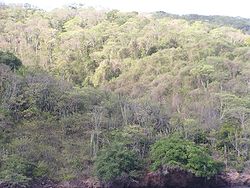- Tropical and subtropical dry broadleaf forests
-
Trinidad and Tobago dry forest on Chacachacare showing the dry-season deciduous nature of the vegetation

The tropical and subtropical dry broadleaf forest biome, also known as tropical dry forest, is located at tropical and subtropical latitudes. Though these forests occur in climates that are warm year-round, and may receive several hundred centimeters of rain per year, they have long dry seasons which last several months and vary with geographic location. These seasonal droughts have great impact on all living things in the forest.
Deciduous trees predominate in most of these forests, and during the drought a leafless period occurs, which varies with species type. Because trees lose moisture through their leaves, the shedding of leaves allows trees such as teak and mountain ebony to conserve water during dry periods. The newly bare trees open up the canopy layer, enabling sunlight to reach ground level and facilitate the growth of thick underbrush. Trees on moister sites and those with access to ground water tend to be evergreen. Infertile sites also tend to support evergreen trees. Three tropical dry broadleaf forest ecoregions, the East Deccan dry evergreen forests, the Sri Lanka dry-zone dry evergreen forests, and the Southeastern Indochina dry evergreen forests, are characterized by evergreen trees.
Though less biologically diverse than rainforests, tropical dry forests are home to a wide variety of wildlife including monkeys, deer, large cats, parrots, various rodents, and ground dwelling birds. Mammalian biomass tends to be higher in dry forests than in rain forests, especially in Asian and African dry forests. Many of these species display extraordinary adaptations to the difficult climate.
This biome is alternately known as the tropical and subtropical dry forest biome or the tropical and subtropical deciduous forest biome. Locally some of these forests are also called monsoon forests, and they tend to merge into savannas.
Contents
Geographical variation
Dry forests tend to exist north and south of the equator rain forest belt, south or north of the subtropical deserts, generally in two bands, one between 10° and 20°N latitude and the other between 20° and 30°S latitude. The most diverse dry forests in the world occur in southern Mexico and in the Bolivian lowlands. The dry forests of the Pacific Coast of northwestern South America support a wealth of unique species due to their dry climate. The subtropical forests of Maputo land-Ponderousin the sub-tropical regions of the United States of America and in southeastern Africa are diverse and support many endemic species. The dry forests of central India and Indochina are notable for their diverse large vertebrate faunas. Madagascar dry deciduous forests and New Caledonia dry forests are also highly distinctive (pronounced extremism and a large number of reliquary taxa) for a wide range of taxa and at higher taxonomic levels. Trees use underground water during the dry seasons.
Biodiversity patterns and requirements
Species tend to have wider ranges than moist forest species, although in some regions many species do display highly restricted ranges; most dry forest species are restricted to tropical dry forests, particularly in plants; beta diversity and alpha diversity high but typically lower than adjacent moist forests.
Effective conservation of dry broadleaf forests requires the preservation of large and continuous areas of forest. Large natural areas are required to maintain larger predators and other vertebrates, and to buffer sensitive species from hunting pressure. The persistence of riparian forests and water sources is critical for many dry forest species. Large swathes of intact forest are required to allow species to recover from occasional large events, like forest fires.
Dry forests are highly sensitive to excessive burning and deforestation; overgrazing and exotic species can also quickly alter natural communities; restoration is possible but challenging, particularly if degradation has been intense and persistent. Degrading dry broadleaf often leaves thorny shrublands, thickets, or dry grasslands in their place.
See also
- Holdridge life zones in Guatemala
- List of national parks of Madagascar
References
- 2006-01-13, Sciencedaily: Deep-rooted Plants Have Much Greater Impact On Climate Than Experts Thought Citat: "...The tap roots transfer rainwater from the surface to reservoirs deep underground and redistribute water...increases photosynthesis and the evaporation of water...by 40 percent in the dry season...During the wet season, these plants can store as much as 10 percent of the annual precipitation as deep as 13 meters (43 feet) underground, to be tapped during the dry months...tree roots acting like pipes to allow water to shift around much faster than it could otherwise percolate through the soil..."
Much material in this article has been reworked from Tropical and Subtropical Dry Broadleaf Forests, by WWF with their permission.
Biomes and Ecozones Terrestrial
biomesPolar/montaneTemperate(Sub)tropicalConiferous forests · Moist broadleaf forests · Dry broadleaf forests · Grasslands, savannas, and shrublandsDryWetAquatic
biomesOther biomes Ecozones External links
Categories:- Tropical and subtropical dry broadleaf forests
- Terrestrial biomes
- Forests
- Tropical flora
Wikimedia Foundation. 2010.

